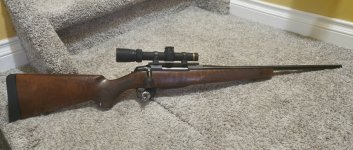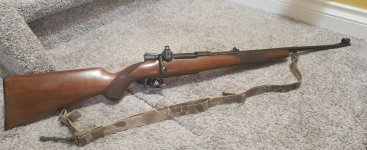With your 6.5x55, 30-06 and 9.3x62 you have a nice 3 rifle battery capable of taking any game on the planet (where legal).
While your 30-06 is definitely capable of taking moose and elk at reasonable hunting distances, the edge with the 9.3 would be the additional energy and penetration for those larger subspecies of these animals (Alaska-Yukon moose), and where shot presentations, may be less than ideal (e.g. quartering to) where more heavy bone may be encountered trying to get that bullet into the vitals for a quick, clean kill. Or when the bullet may not have hit the animal as accurately as intended.
Best of luck finding the ammo or handload that your rifle shoots best, and may you have plenty of great adventures with it!
I have a LH Sako 85 Hunter in 9.3x62 and am using the Nosler factory 250 gr AccuBond ammo in it so far. I haven't chronied this ammo, but it is spec'd at 2,550 fps, and 3609 ft.lbs of energy. Zeroed for 200 yards, it is 2.3" high @ 100 yards and 9.3" low at 300 yards. It retains enough velocity for reliable expansion to 400 yards,where it is 36.7" low and still retaining 1932 fps and 2072 ft.lbs of energy. (still legal for bison in BC at this range)
The rifle is producing 0.674" groups at 100 yards with this ammo. (the Norma Alaskan 285 gr ammo is producing groups of 1.026", and the Lapua Mega 285 gr ammo is producing 1.406" groups @ 100 yards, in my rifle.)
I have taken a young bull moose at 178 yards. Quartering to, I aimed for the high shoulder shot to keep it from heading into the muskeg on one side, or back into the deep ravine where it had come out of on the other. The shot hit the spine and penetrated approx. 2 feet of heavy bone, and had retained a large percentage of its original weight, and expanded approx. 2 times its original diameter (sorry, I cannot locate my data for this a exact info at the moment).
As I will be using this rifle predominately for moose, bear and bison, I feel that the 250 gr bullet will be plenty sufficient for the duty I am asking of it, and do not feel the need for the heavier bullet weight. And since it shoots this load better, I am happy to stick to this bullet.
Perhaps I will get a chance to take it to Africa for eland and cape buffalo, someday. Or Alaska for brown bear...
I plan on trying Re-15, IMR 4064 and Varget in working up handloads with this bullet, to the same velocity specs, and see if I can duplicate, or better, the accuracy in my rifle.
My rifle is scoped with a Kahles Helia C 1.5-6x42 in Optiloc rings and bases and weighs 8 lbs 15 oz. with a loaded magazine (5 rounds).
Felt recoil is roughly at 30-32 ft. lbs. As described above, it is more of a push than a sharp smack.
While your 30-06 is definitely capable of taking moose and elk at reasonable hunting distances, the edge with the 9.3 would be the additional energy and penetration for those larger subspecies of these animals (Alaska-Yukon moose), and where shot presentations, may be less than ideal (e.g. quartering to) where more heavy bone may be encountered trying to get that bullet into the vitals for a quick, clean kill. Or when the bullet may not have hit the animal as accurately as intended.
Best of luck finding the ammo or handload that your rifle shoots best, and may you have plenty of great adventures with it!
I have a LH Sako 85 Hunter in 9.3x62 and am using the Nosler factory 250 gr AccuBond ammo in it so far. I haven't chronied this ammo, but it is spec'd at 2,550 fps, and 3609 ft.lbs of energy. Zeroed for 200 yards, it is 2.3" high @ 100 yards and 9.3" low at 300 yards. It retains enough velocity for reliable expansion to 400 yards,where it is 36.7" low and still retaining 1932 fps and 2072 ft.lbs of energy. (still legal for bison in BC at this range)
The rifle is producing 0.674" groups at 100 yards with this ammo. (the Norma Alaskan 285 gr ammo is producing groups of 1.026", and the Lapua Mega 285 gr ammo is producing 1.406" groups @ 100 yards, in my rifle.)
I have taken a young bull moose at 178 yards. Quartering to, I aimed for the high shoulder shot to keep it from heading into the muskeg on one side, or back into the deep ravine where it had come out of on the other. The shot hit the spine and penetrated approx. 2 feet of heavy bone, and had retained a large percentage of its original weight, and expanded approx. 2 times its original diameter (sorry, I cannot locate my data for this a exact info at the moment).
As I will be using this rifle predominately for moose, bear and bison, I feel that the 250 gr bullet will be plenty sufficient for the duty I am asking of it, and do not feel the need for the heavier bullet weight. And since it shoots this load better, I am happy to stick to this bullet.
Perhaps I will get a chance to take it to Africa for eland and cape buffalo, someday. Or Alaska for brown bear...
I plan on trying Re-15, IMR 4064 and Varget in working up handloads with this bullet, to the same velocity specs, and see if I can duplicate, or better, the accuracy in my rifle.
My rifle is scoped with a Kahles Helia C 1.5-6x42 in Optiloc rings and bases and weighs 8 lbs 15 oz. with a loaded magazine (5 rounds).
Felt recoil is roughly at 30-32 ft. lbs. As described above, it is more of a push than a sharp smack.








































































